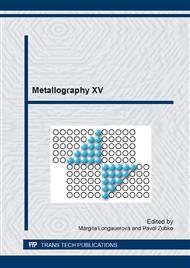p.449
p.453
p.457
p.461
p.467
p.473
p.480
p.487
p.491
Microstructure Development in Powder Metallurgy Steels: Effect of Alloying Elements and Process Variables
Abstract:
Microstructure of the powder metallurgy (PM) steels and especially mechanism of its formation differs significantly from the microstructure of the conventional steels even if composition will be exactly the same. The difference is not only connected to the presence of the pores, which are inalienable feature of the PM parts. Presence of the prior inter-particle boundaries, which can be contaminated by residual oxides, as well as microstructure heterogeneity are another characteristic features of the microstructure of PM steels. Microstructure heterogeneity is connected to the PM manufacturing process: powder mix, consisting of the base powder and additional alloying elements is compacted and then sintered. Fully prealloyed powder is not always possible to use in standard press & sintering route due to the solid solution strengthening of the ferrite resulting in bad powder compressibility. Hence, in order to provide good powder compressibility only pure iron or low-alloyed (typically <3 wt.%) powders are used. Required alloying elements and carbon (added as graphite) are further admixed in the powder form and are distributed during sintering by diffusion into iron particles at high temperatures. To assure satisfactory distribution of alloying elements, oxide layer, covering surface of the powder particles and hindering mass-transfer of the alloying elements, has to be removed first. This can be done by gaseous reducing agents as hydrogen and carbon monoxide. However, their cost and/or purity are of issue for modern alloyed PM steels. Admixed carbon, additionally to its function as alloying element, plays a role of effective reducing agent at higher temperatures. Paper summarizes the main features of microstructure formation during the whole sintering cycle (heating and isothermal sintering) and effect of alloying additives (different carbon sources, alloying elements) and processing parameters (sintering atmosphere composition, temperature profile) on the microstructure formation during conventional sintering process. Results indicate that for successful sintering of alloyed PM steels with homogeneous defect-free microstructure, hydrogen-rich atmospheres and high-temperature sintering are required.
Info:
Periodical:
Pages:
467-472
Citation:
Online since:
April 2014
Authors:
Price:
Сopyright:
© 2014 Trans Tech Publications Ltd. All Rights Reserved
Share:
Citation:


